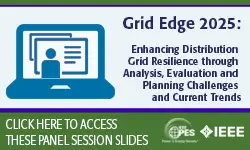Unlocking the Flexibility of Supply and Demand Side for a Future Decarbonized Grid
Le Xie, Ning Kang, Brent Buffington, Debbie Lew, Aidan Tuohy
-
Members: FreePES
IEEE Members: $25.00
Non-members: $40.00Pages/Slides: 69
Panel
09 May 2024
As the grid further decarbonizes and the penetration of variable energy resources increases, unlocking flexibility is key to enabling power systems reliability, resilience, affordability, sustainability, and security. This panel focuses on the fundamentals and technologies to maximize flexibility from generation and load resources that can respond to uncertainties of conditions. The panel will start with fundamental methods to assess flexibility from individual devices, to hybrid resources that combine multiple energy sources, storage, and energy conversion technologies, culminating in assessing the amount of flexibility we currently have in our current grid and how much flexibility we will need for a future decarbonized grid. The panel will continue to discuss the challenges to unleash supply- and demand-side flexibility – identified by the Flexible Generation and Load pillar under the Department of Energy’s Grid Modernization Initiative. These challenges range from market, policy and regulation, to valuation, and technology development. The panelists will share exemplar RD&D experiences in addressing some of these challenges. Specific projects that will be covered include nuclear-hydrogen integration with several nuclear power plants, solar and storage integration with multiple utilities, and hydropower and storage integration with municipal and co-op utilities throughout the country. The benefits of supply-side flexibility such as increased utilization of transmission and distribution networks, reliability, resilience, and environmental benefits, and lowering the costs for the whole system will also be discussed in-depth in this panel. Load technologies that have traditionally been passive consumption devices are rapidly evolving to incorporate intelligence for responding to grid conditions and enabling more demand-side flexibility. Demand response as a traditional demand flexibility technology is still underutilized. In the meantime, integrating on-site DERs – including distributed generation, energy storage, and electric vehicles (EVs) – with loads is an emerging method that offers great potential to further enable load flexibility for utilities and system operators. These demand flexibility solutions can not only reduce, shed, or shift energy consumption but can also modulate and generate electricity for the grid. The panelists will talk about the challenges facing demand flexibility and make recommendations for addressing the top barriers to demand flexibility adoption and deployment. Panelists are planned represent a university, an industry organization, a national laboratory and a research organization.
Chairs:
Aidan Tuohy, Ning Kang
Primary Committee:
Renewables Systems IntegrationCoordinating
Sponsor Committees:
Renewables Systems Integration Coordinating



